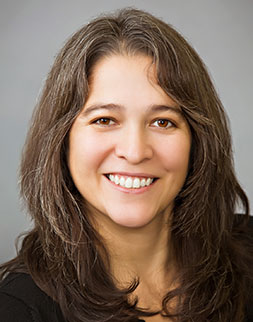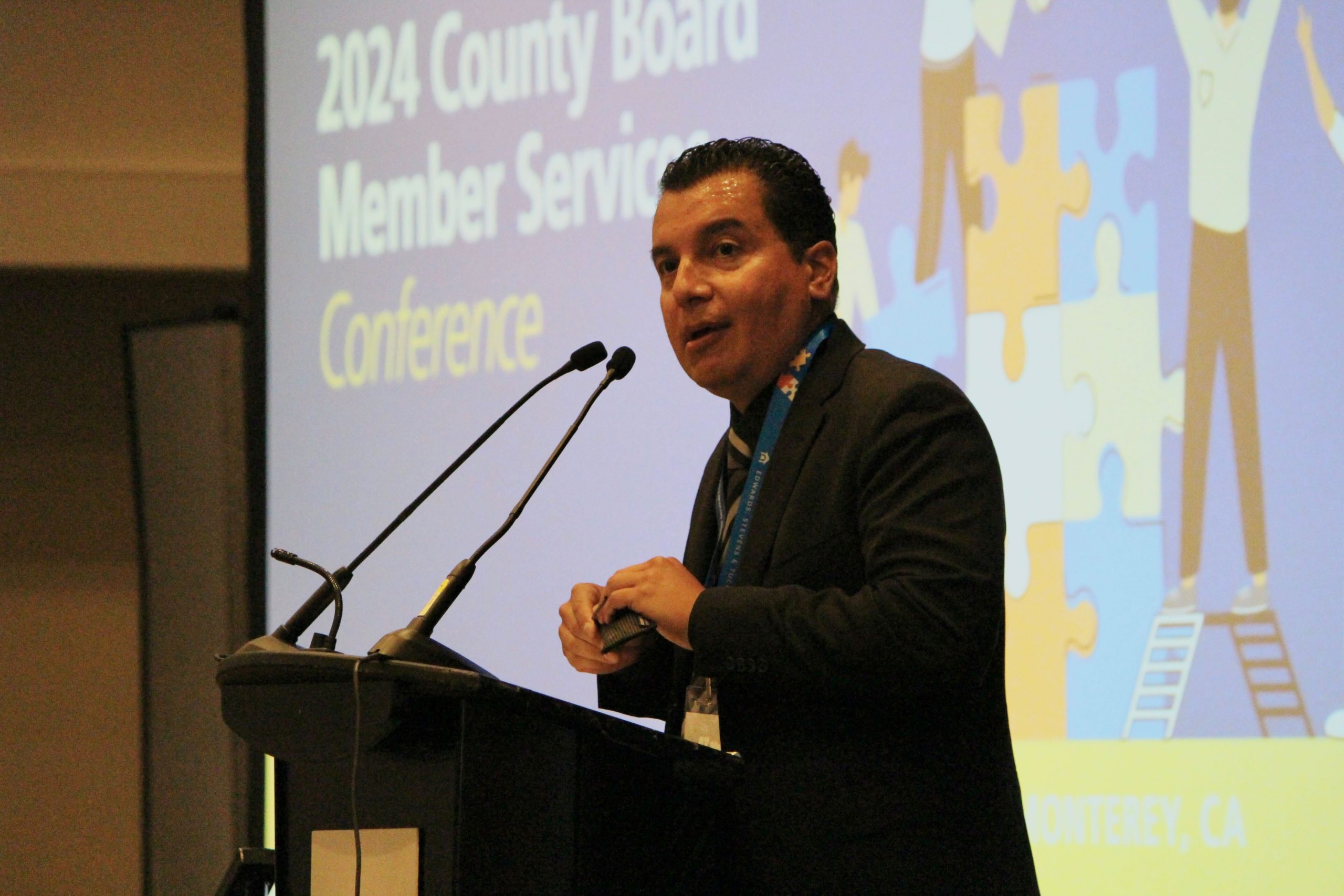Xilonin Cruz-Gonzalez is a trustee of the Azusa Unified School District in east Los Angeles County. Now in her 18th year as a school board member, Cruz-Gonzalez has been an active member of CSBA, and has served as President-elect, Vice President and on the CSBA Board of Directors representing the greater San Gabriel Valley.
As an advocate for the state’s public education system and a committed lifelong learner, Cruz-Gonzalez has also served on CSBA’s Legislative Committee and the Council of Presidents. In addition to her advocacy work through CSBA, Cruz-Gonzalez works for Californians Together, directing a project that supports immigrant and refugee students.
Tell us a little about your background, including your own K-12 education and professional experience.
I grew up in Azusa — that’s where I was born. Actually, my grandfather was born there in 1924. I’m the eldest of four. I went to kindergarten in our public schools for one year. Then, after that one year, my mom made a decision and pulled me out of public school and sent me to private school. So, I actually didn’t have experience in the public schools for the majority of my K-12 experience. I often wonder, if I had been in public school, whether I would have ended up at MIT [Massachusetts Institute of Technology], which is where I went to college. And that’s part of the driver of why I ran to be a school board representative, because I feel like every student should have the chance and opportunity to meet their dreams and to achieve their goals. So, that really is why I ran. I’m really proud to say that in the last five to six years we have had several kids go to MIT from our Azusa Unified School District and do really well there.
In terms of running for school board, I wanted to see that every student in our school district had a chance to achieve their dreams — graduate college, be college and career ready, and be able to step out the door and do whatever they wanted. That’s really been my driving force on the school board. I never thought I was going to go into working in the education space. I thought I was going to be working as an engineer. But as I got more involved in education, moving closer to the school board, I realized education is just so important, so critical. It’s really the bedrock of success and the future of our country and our society. And I’ve had the opportunity to work in the education policy space both at the state level and at the federal level, really pushing and advocating for equitable policies that can help students succeed in our schools for the last 15 years.
What is your vision for the future of public school education in California?
I have a really specific vision. I would love to see every single student, every single child in the state graduate what I would consider a global citizen. What I mean by that is a couple of things: one, I think society is changing so rapidly with technological advances that kids have to come out of school ready for anything. They must be ready for change and they must be adaptable. You see this with a lot of the 21st-century skills that we talk about. And I think that it’s really important that we’re reinforcing those pieces around collaboration, creativity, being able to explore, and being able to continue to learn as you grow, because things are going to change so rapidly.
The other part of that is we are very much becoming a global society. And so, I would love to see every single student who graduates in California be literate in more than one language. I think that is an asset. You see that in other countries. I would love for that to happen in California. But that can’t happen — neither of those things can happen — without a really strong focus from school board members.
What do you see as the challenges to these goals?
I would say the biggest challenge is Full and Fair FundingSM, and I think this is why it’s a very important issue for CSBA. We expect these wonderful outcomes for our students. Yet, we don’t put the money in our systems so that we as educational assistants at districts or schools, even as educators in the classroom, can produce those outcomes that we want for our students. It comes down to something really basic — do we have enough money to fund all the supports that are needed so that students have access to this really wonderful education and are ready for the future that they’re facing? Full and Fair Funding is critical.
I think the other big piece is that we’re living within an educational system. It is a structure that was developed several centuries ago, and very little has changed — in terms of how we sit children in a classroom, how we interact with children. I really feel if we want to truly realize the potential of these students and understand where they’re going, we have to be self-reflective and think about how we can transform our systems. And I see it happening in districts across the state. I would say it doesn’t happen everywhere — I myself am guilty of not trying to think outside that box and think about how we truly transform the educational experience of students. But I think that we do have to, that is a critical piece.
How does your work as an advocate for supporting immigrant and refugee students influence your vision for public education in California?
I feel very lucky that I get to work for an organization called Californians Together, which has the goal of championing the success of English learners. I direct a project called Support for Immigrant and Refugee Students. The purpose of that project is to develop resources and training and support best practices for educators, for schools and for school systems around how to best support immigrant and refugee students. How do you create safe and inclusive environments for immigrant and refugee students?
In terms of how it’s driven my work at the school board level, it’s had a deep impact for two reasons. One, I think I’ve been able to see very clearly the challenges of when you have a well-intentioned or a very good state policy at the state level that then through legislation pushes districts to adopt local policies. And I’m actually referencing Assembly Bill 99, which is educational equity for immigrant students. When you adopt something but there’s really no guidance — there may or may not be implementation in terms of the policies. I think for me as a board member, it’s really made me reflect on how we are supporting the educators in the system when we push policies and priorities in the local district. How are we ensuring that we are supporting the educators in the system? How are we ensuring that we have plans so that we can see implementation of those visions that we’re laying forward?
I would say the other piece that I feel I’m so grateful for is that I’ve been able to see some really amazing programs and approaches in schools and districts across the state, where they have created these wonderful, safe and inclusive environments for immigrant and refugee students.
Where do you think CSBA can focus in order to help drive the education agenda and improve outcomes for today’s students?
I think it’s worth repeating that Full and Fair Funding is so critical. If you don’t have that funding, you can’t do any of the other things. You cannot think about transforming your systems. You cannot think about investing in district priorities. For example, if a local district board decides that arts are critical, it doesn’t help to bring in some kind of packaged curriculum — I think you need to have somebody with artistic ability leading students and teaching them how to express themselves artistically, and that costs money. Today, you see very few art teachers in schools across the state. And that’s really because we don’t have the funding to prioritize that. We have to focus on making sure we have just the basics. So that to me is why Full and Fair Funding is the most important piece.
One of the big challenges/opportunities for board members is creating equitable learning environments that help close achievement gaps.
Do you have any thoughts on how school boards can provide equity-centered leadership?
I’m very proud that [during the September meeting] the CSBA Board of Directors adopted an Equity Statement. It starts off by acknowledging that excellent boards of education are equity driven. You’re talking about equity centered, but if we really want to see the outcomes that we profess for our students, equity has to be at the core of how we operate. And what I mean by that is, we know that each student, even each student group, has certain needs. And we have an opportunity as a school board to focus on those needs.
That’s really what equity means — we want to make sure that we’re focusing on the needs of individual students or student groups. And this is a critical piece that I think often is hard to connect. We need to align our programs and especially our budgets to fund that work. It’s very difficult sometimes to think about how we shift resources or how we shift the focus of our staff to make sure that students are getting what we need.
I think the other critical piece is how we look at data and what we consider data. I think people often default to thinking of data as test scores, but there’s a plethora of data out there and boards have to be really thoughtful about what kind of outcomes they want to achieve; what kind of information they need to achieve those outcomes. That’s really how we should look at data, as information we need to be able to achieve those outcomes. And we need to keep thinking about how we are going to monitor that information, that data, to see if the things that we’re investing in are working. And I think that is often a very difficult conversation for school boards to have.
As a veteran board member, what advice would you give to new or aspiring board members?
I think it’s so important to learn as much as you can. I think whether you come from an education background or you don’t, sitting behind that dais and being a board member is something you don’t really understand what it means until you’ve actually done it. It’s really important to make sure that you get training and that you continue to increase your knowledge to be a successful board member.
There’s so much information and new research that comes out all of the time. It’s difficult to keep up, but if you want to be effective, you have to know that what you’re pushing and what you’d like to achieve and align your priorities with what works.
The other piece that I think is really critical is building connections. I feel like I have gained so much knowledge from networking and meeting other board members from across the state because we all have different perspectives. We all have different knowledge sets and different experiences. I’ve been able to build these relationships with board members in my region and even across the state. I really feel like it’s helped me become a better board member.
Why did you become active in CSBA and why would you encourage board members to get involved with the organization?
I think being active in CSBA is critical. As I mentioned before, I really believe that to do well at your job, or any job, is to really have an interest in what you’re doing and continue to learn. CSBA is the best place to go to understand school board governance and to understand education policy in California. That’s why I think CSBA is such a valuable piece for us as board members. I think being able to engage with CSBA, whether it’s through regional activities or at the annual conference, gives you an opportunity to meet other people that have your same experiences and maybe you can learn from each other. You can find people that you feel that you can turn to if you have questions or really just find fellowship with people. CSBA is the place that provides that in California.





